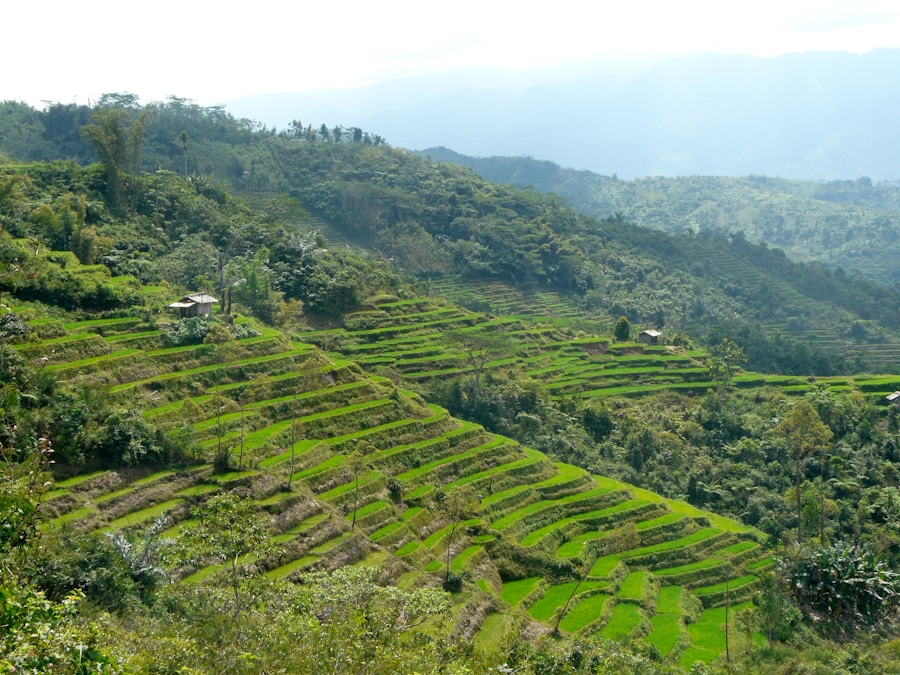Download links
How to install Banaue Rice Terraces: A Wonder of Ancient Engineering APK?
1. Tap the downloaded Banaue Rice Terraces: A Wonder of Ancient Engineering APK file.
2. Touch install.
3. Follow the steps on the screen.
Description
Nestled in the mountainous region of the Philippines, the Banaue Rice Terraces are often referred to as the “Eighth Wonder of the World.” This breathtaking landscape, carved into the mountainsides over 2,000 years ago, showcases the ingenuity and resilience of the indigenous Ifugao people. The terraces stretch over 2,000 square kilometers and rise to elevations of about 1,500 meters above sea level, creating a stunning visual tapestry of verdant green fields that cascade down the mountains. The terraces are not merely agricultural plots; they represent a harmonious relationship between humans and nature, where traditional farming practices have been meticulously maintained through generations.
The Banaue Rice Terraces are more than just a picturesque site; they are a living testament to the cultural heritage of the Ifugao people. The terraces are intricately linked to their way of life, spirituality, and social structure. Rice cultivation is not only a means of sustenance but also a vital component of their cultural identity.
The terraces serve as a backdrop for various rituals and festivals that celebrate the agricultural cycle, reinforcing the community’s connection to their land and ancestors. As such, the Banaue Rice Terraces stand as a symbol of resilience, showcasing how traditional practices can thrive in harmony with nature.
Key Takeaways
- The Banaue Rice Terraces are a UNESCO World Heritage site and are often referred to as the “Eighth Wonder of the World.”
- The terraces were built over 2,000 years ago by the Ifugao people and are a testament to their engineering and agricultural skills.
- The construction of the terraces involved the use of stone and mud walls to create flat platforms on the steep mountainsides for rice cultivation.
- Efforts to preserve and conserve the terraces include community-based initiatives, sustainable farming practices, and tourism regulations.
- While the terraces attract tourists from around the world, it’s important to respect the local culture, environment, and follow responsible tourism practices when visiting.
History and Cultural Significance
The history of the Banaue Rice Terraces is deeply intertwined with the Ifugao people’s agricultural practices and spiritual beliefs. It is believed that the terraces were constructed around 2000 years ago, primarily for rice cultivation, which is a staple food in the region. The Ifugao people developed sophisticated farming techniques that allowed them to adapt to the challenging mountainous terrain.
They utilized a system of irrigation that harnessed rainwater and diverted it through a network of canals, ensuring that each terrace received adequate water for crop growth. This intricate system reflects not only their agricultural knowledge but also their understanding of environmental sustainability. Culturally, the rice terraces hold immense significance for the Ifugao people.
They are not merely fields; they are sacred spaces that embody ancestral wisdom and traditions. The construction and maintenance of the terraces involve communal labor, fostering a strong sense of community among the Ifugao. Festivals such as the Imbayah, which celebrates the rice harvest, highlight the importance of rice in their culture and serve as an opportunity for communal bonding.
The terraces also play a role in various rituals, including those related to fertility and harvest, underscoring their spiritual significance. Thus, the Banaue Rice Terraces are not just agricultural marvels; they are integral to the identity and continuity of Ifugao culture.
Engineering and Construction Techniques

The engineering prowess demonstrated in the construction of the Banaue Rice Terraces is nothing short of remarkable. The terraces were built using simple tools and techniques that have been passed down through generations. The Ifugao people utilized locally sourced materials such as stone, wood, and bamboo to create sturdy walls that retain soil and water.
The terraces are designed to follow the contours of the mountainside, minimizing soil erosion and maximizing water retention. This careful planning reflects an advanced understanding of hydrology and topography. One of the most impressive aspects of the terraces is their irrigation system.
The Ifugao developed a complex network of canals that channel water from nearby rivers and streams directly to each terrace. This system ensures that water is distributed evenly across all fields, allowing for optimal crop growth. The construction process itself was labor-intensive, requiring not only physical strength but also a deep knowledge of the land’s characteristics.
Families would work together to build and maintain these terraces, reinforcing social bonds while ensuring food security for their communities. The engineering techniques employed in the Banaue Rice Terraces exemplify sustainable agricultural practices that have stood the test of time.
Preservation and Conservation Efforts
| Country | Protected Areas (sq km) | Species under Conservation | Investment in Conservation () |
|---|---|---|---|
| United States | 1,300,000 | 1,200 | 4,000,000,000 |
| Brazil | 1,500,000 | 1,800 | 3,500,000,000 |
| Australia | 1,200,000 | 1,500 | 2,800,000,000 |
In recent years, the Banaue Rice Terraces have faced numerous challenges that threaten their existence. Factors such as climate change, urbanization, and shifts in agricultural practices have put immense pressure on this UNESCO World Heritage site. Recognizing the importance of preserving this cultural landscape, various organizations and local governments have initiated conservation efforts aimed at safeguarding both the terraces and the traditional practices associated with them.
One significant initiative involves promoting sustainable tourism that benefits local communities while raising awareness about the importance of preserving the terraces. By encouraging visitors to engage with local farmers and learn about traditional farming methods, these programs foster a deeper appreciation for the cultural significance of the rice terraces. Additionally, educational campaigns aimed at younger generations within the Ifugao community emphasize the importance of maintaining their ancestral heritage.
Workshops on traditional farming techniques and environmental stewardship are being organized to ensure that this knowledge is passed down. Moreover, partnerships between local governments and international organizations have led to funding for restoration projects aimed at repairing damaged terraces and improving irrigation systems. These efforts not only help restore the physical landscape but also empower local communities by providing them with resources and training to sustain their agricultural practices.
Through these collaborative initiatives, there is hope for preserving the Banaue Rice Terraces as both an agricultural marvel and a cultural treasure.
Impact on the Environment and Local Communities
The Banaue Rice Terraces have a profound impact on both the environment and local communities. From an ecological perspective, these terraces play a crucial role in maintaining biodiversity in the region. The diverse crops grown in these fields contribute to soil health and promote a balanced ecosystem.
Additionally, the terraces help prevent soil erosion by stabilizing slopes and retaining moisture, which is vital in a region prone to heavy rainfall. For local communities, the rice terraces are not just a source of food; they are also integral to their economic well-being. Rice farming provides livelihoods for many families in Ifugao, allowing them to sustain themselves while preserving their cultural heritage.
The terraces also attract tourists from around the world, generating income for local businesses such as homestays, restaurants, and guided tours. This influx of visitors has created opportunities for cultural exchange and has raised awareness about the importance of preserving traditional practices. However, this reliance on tourism also presents challenges.
Increased foot traffic can lead to soil compaction and erosion if not managed properly. Additionally, as younger generations migrate to urban areas in search of better opportunities, there is a risk that traditional farming practices may decline. Balancing economic development with environmental sustainability is crucial for ensuring that both the rice terraces and local communities can thrive in harmony.
Visiting the Banaue Rice Terraces: Tips and Recommendations

For those interested in experiencing the beauty and cultural richness of the Banaue Rice Terraces firsthand, planning a visit requires some thoughtful consideration. The best time to visit is during the dry season from November to April when weather conditions are more favorable for trekking and exploring the terraces. During this period, visitors can witness vibrant green fields filled with rice plants ready for harvest or enjoy breathtaking views as they hike along well-marked trails.
When visiting, it is essential to respect local customs and traditions. Engaging with local farmers can provide valuable insights into their way of life while supporting their livelihoods. Many farmers offer guided tours that allow visitors to learn about traditional farming techniques and participate in activities such as planting or harvesting rice.
This immersive experience fosters a deeper appreciation for the cultural significance of the terraces. Accommodations range from budget-friendly guesthouses to more upscale lodges that offer stunning views of the terraces. It is advisable to book accommodations in advance during peak tourist seasons to ensure availability.
Additionally, travelers should consider hiring local guides who possess extensive knowledge about both the history of the terraces and their ecological significance. These guides can enhance your experience by sharing stories about their culture while ensuring that you navigate safely through this stunning landscape. In conclusion, visiting the Banaue Rice Terraces offers an opportunity not only to witness an extraordinary feat of engineering but also to connect with a rich cultural heritage that has endured for millennia.
By approaching your visit with respect and curiosity, you can contribute positively to both the preservation of this UNESCO World Heritage site and the well-being of its local communities.
If you are interested in learning more about sustainable practices in agriculture, you may want to check out this article on the future of fishing in Indonesia science/2025/02/28/perspektif-pangingisda-masa-depan-perikanan-indonesia/’>here.
It discusses the importance of preserving marine resources for future generations and offers insights into how the fishing industry can adapt to changing environmental conditions.
FAQs
What are the Banaue Rice Terraces?
The Banaue Rice Terraces are ancient terraces carved into the mountains of Ifugao in the Philippines. They are often referred to as the “Eighth Wonder of the World” and are a UNESCO World Heritage Site.
How were the Banaue Rice Terraces created?
The terraces were hand-carved by the Ifugao people over 2,000 years ago using minimal equipment. They were created to make the mountainous terrain suitable for rice cultivation.
What is the significance of the Banaue Rice Terraces?
The terraces are a symbol of the ingenuity and sustainable agricultural practices of the Ifugao people. They also serve as a cultural landscape that reflects the harmony between humans and nature.
How large are the Banaue Rice Terraces?
The terraces cover approximately 10,360 square kilometers of mountainside and are estimated to stretch about 20,000 kilometers if connected end to end.
Can visitors explore the Banaue Rice Terraces?
Yes, visitors can explore the terraces and hike along the trails that connect the different villages. However, it is important to respect the local customs and environment while visiting.





